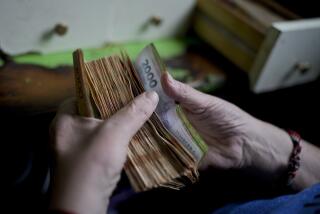Brazil Introduces New Currency : Economy: The change was part of the eighth economic plan in 12 years. The goal is to drive down chronic inflation, which exceeded 2,700% last year.
- Share via
RIO DE JANEIRO — Manuel Lira dos Santos spread his thick, muscled arms out toward the throng of buyers and vegetable and meat vendors haggling over prices Friday in the huge outdoor weekly Ipanema market.
He sighed. “Everybody is a little crazy today,” he said from behind the stand where he sells chicken parts. “You can feel it. Everybody is a little nuts today.”
And why shouldn’t they be? The entire country changed money in what may be one of the globe’s largest currency swaps. For Brazil, the exchange was part of its eighth economic plan in 12 years, the latest effort to drive down the dizzying inflation that has plagued this country for more than a decade.
On Friday, from remote patches in the Amazon to the huge commercial center of Sao Paulo, a nation of 155 million people--who participate in the world’s eighth-largest economy--began switching $5 billion worth of cruzeiro reals to the real, a new currency pegged to the U.S. dollar, in what one economist likened to “changing the engine on a 747 while it’s still in flight.”
Government officials hope that the new currency, backed by $40 billion in reserves, can beat down inflation, which last year topped 2,700% and which was running at 50% for just last month.
In brief, the theory is that Brazil’s money change will break the inflationary psychology: There will be fewer units of currency chasing after goods, and the value of the money will be more firmly anchored.
Analysts predict that the plan will almost surely have an immediate impact, possibly pushing inflation down to a mere 2% monthly by mid-August. The question, for which nobody has an answer, is how long this will last.
On Friday, the confusion, hope, frustration and anxiety among shoppers around Dos Santos’ stand stood as microcosm of a nation that is greeting a new plan that effectively has forced everyone to deal with high mathematics to calculate what costs what.
“I won’t pay in reals! I won’t pay in reals!” shouted one woman as she eyed Dos Santos’ prices posted in the new currency. He calmed her by reminding her that cruzeiros are still good for a time, then whipped out his pocket calculator to figure the price in the old money.
“Normally, almost nobody brings a calculator, but, today, everybody has one,” Dos Santos said as he punched in the numbers: 2,700 cruzeiro reals for one real.
Customers, however, remain confused.
“What is two reals?” one woman whispered to her husband as she eyed Dos Santos’ chicken necks.
Confusion on Friday kept shoppers away, vendors agreed, particularly in the poorer sections of town where the uneducated and even the merchants had difficulty figuring prices.
Shoppers are particularly wary because most merchants have increased prices sharply in anticipation of government steps to freeze them, as part of the real-linked inflation fight; incomes were virtually frozen, as the government did away with monthly salary increases, designed to keep up with inflation.
“Sometimes I think I’m hallucinating when I see the prices,” said lawyer Vera Lucia Viana, shaking her head at Dos Santos’ wares.
She was discussing a major criticism of the government anti-inflation plan, an objection that has been raised particularly by union leaders, such as Vicente Paulo da Silva, president of the largest union in Latin America. Opponents say the plan has eroded worker salaries and “frozen the poor in their misery.”
But economists, such as Helio Portocarrero, a university professor and head of the local Economics Council, are unconcerned.
“The prices which are unrealistic will have to come back down as the currency stabilizes,” he said.
Paulo claims that the real comes suspiciously at a time when it could help the presidential campaign of Fernando Henrique Cardoso, the former finance minister who devised the plan. Cardoso, now trailing front-runner Luis Inacio Lula da Silva in the polls, has staked much of his campaign on the plan’s success.
“If it works, it will certainly make me look much more favorably on him,” said Joao Paulo Loureiro Martin, 54, a marble salesman at the market.
As for Dos Santos, he doesn’t really care about Cardoso; he just hopes that the plan will be good for business.
Economists hope so too, but not immediately.
If consumers embark on a buying spree, they fear, it will fuel inflation. Consequently, banks are expected to raise interest rates to 5% monthly to make saving more desirable.
High interest rates will also boost the economy by attracting foreign investment, which already has been on the upswing in anticipation of the real.
More to Read
Sign up for Essential California
The most important California stories and recommendations in your inbox every morning.
You may occasionally receive promotional content from the Los Angeles Times.













